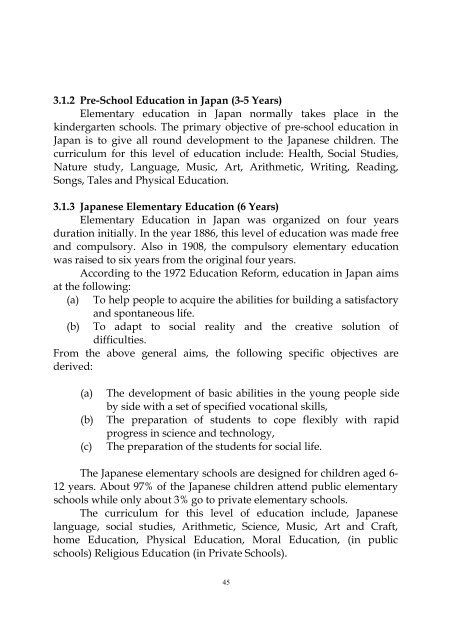edu 304 - comparative education - National Open University of Nigeria
edu 304 - comparative education - National Open University of Nigeria
edu 304 - comparative education - National Open University of Nigeria
You also want an ePaper? Increase the reach of your titles
YUMPU automatically turns print PDFs into web optimized ePapers that Google loves.
3.1.2 Pre-School Education in Japan (3-5 Years)<br />
Elementary <strong>edu</strong>cation in Japan normally takes place in the<br />
kindergarten schools. The primary objective <strong>of</strong> pre-school <strong>edu</strong>cation in<br />
Japan is to give all round development to the Japanese children. The<br />
curriculum for this level <strong>of</strong> <strong>edu</strong>cation include: Health, Social Studies,<br />
Nature study, Language, Music, Art, Arithmetic, Writing, Reading,<br />
Songs, Tales and Physical Education.<br />
3.1.3 Japanese Elementary Education (6 Years)<br />
Elementary Education in Japan was organized on four years<br />
duration initially. In the year 1886, this level <strong>of</strong> <strong>edu</strong>cation was made free<br />
and compulsory. Also in 1908, the compulsory elementary <strong>edu</strong>cation<br />
was raised to six years from the original four years.<br />
According to the 1972 Education Reform, <strong>edu</strong>cation in Japan aims<br />
at the following:<br />
(a) To help people to acquire the abilities for building a satisfactory<br />
and spontaneous life.<br />
(b) To adapt to social reality and the creative solution <strong>of</strong><br />
difficulties.<br />
From the above general aims, the following specific objectives are<br />
derived:<br />
(a) The development <strong>of</strong> basic abilities in the young people side<br />
by side with a set <strong>of</strong> specified vocational skills,<br />
(b) The preparation <strong>of</strong> students to cope flexibly with rapid<br />
progress in science and technology,<br />
(c) The preparation <strong>of</strong> the students for social life.<br />
The Japanese elementary schools are designed for children aged 6-<br />
12 years. About 97% <strong>of</strong> the Japanese children attend public elementary<br />
schools while only about 3% go to private elementary schools.<br />
The curriculum for this level <strong>of</strong> <strong>edu</strong>cation include, Japanese<br />
language, social studies, Arithmetic, Science, Music, Art and Craft,<br />
home Education, Physical Education, Moral Education, (in public<br />
schools) Religious Education (in Private Schools).<br />
45
















